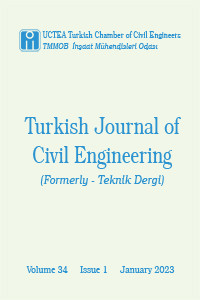A Relationship for Effective Thermal Conductivity of Reinforced Concrete Structures
A Relationship for Effective Thermal Conductivity of Reinforced Concrete Structures
Thermal conductivity, thermal analysis reinforced concrete, reinforcement, finite element analysis, pier cap,
___
- Kim, K.-H., Jeon, S.-E., Kim, J.-K., and Yang, S., “An experimental study on thermal conductivity of concrete,” Cement and Concrete Research, vol. 33, no. 3, pp. 363–371, Mar. 2003, doi: 10.1016/S0008-8846(02)00965-1.
- Davraz, M., Koru, M. and Akdağ, A.E.,“The Effect of Physical Properties on Thermal Conductivity of Lightweight Aggregate,” Procedia Earth and Planetary Science, vol. 15, pp. 85–92, Jan. 2015, doi: 10.1016/j.proeps.2015.08.022.
- Fraternali, F., Ciancia, V., Chechile, R., Rizzano, G., Feo, L., and Incarnato, L.,“Experimental study of the thermo-mechanical properties of recycled PET fiber-reinforced concrete,” Composite Structures, vol. 93, no. 9, pp. 2368–2374, Aug. 2011, doi: 10.1016/j.compstruct.2011.03.025.
- Kanbur, B., Atayilmaz, S., Demir, H., Koca, A., and Gemici, Z., “Investigating the Thermal Conductivity of Different Concrete and Reinforced Concrete Models with Numerical and Experimental Methods,” Advances in Mechanical Engineering Applications, 2013.
- Agrawal, A. and Satapathy, A., “Mathematical model for evaluating effective thermal conductivity of polymer composites with hybrid fillers,” International Journal of Thermal Sciences, vol. 89, pp. 203–209, Mar. 2015, doi: 10.1016/j.ijthermalsci.2014.11.006.
- Noh, H.G., Kang, H.C., Kim, M.H., and Park, H.S., “Estimation Model for Effective Thermal Conductivity of Reinforced Concrete Containing Multiple Round Rebars,” International Journal of Concrete Structures and Materials, vol. 12, no. 1, p. 65, Oct. 2018, doi: 10.1186/s40069-018-0291-2.
- Kim, H.K., Jeon, J.H., and Lee, H.K., “Workability, and mechanical, acoustic and thermal properties of lightweight aggregate concrete with a high volume of entrained air,” Construction and Building Materials, vol. 29, pp. 193–200, Apr. 2012, doi: 10.1016/j.conbuildmat.2011.08.067.
- Yun, T.S., Jeong, Y.J., Han, T.S., and Youm, K.S., “Evaluation of thermal conductivity for thermally insulated concretes,” Energy and Buildings, vol. 61, pp. 125–132, Jun. 2013, doi: 10.1016/j.enbuild.2013.01.043.
- US Army Corps of Engineers, “CRD-C36-73 Method of Test for Thermal Diffusivity of Concrete,” CRD-C36-73, 1973.
- Lin, Y. and Chen, H.-L., “Thermal analysis and adiabatic calorimetry for early-age concrete members,” Journal of Thermal Analysis and Calorimetry, vol. 122, no. 2, pp. 937–945, Nov. 2015, doi: 10.1007/s10973-015-4843-2.
- Van Breugel, K., “Prediction of temperature development in hardening concrete,” Prevention of thermal cracking in concrete at early ages, vol. 15, pp. 51–75, 1998.
- Bas, B. E., "Study on The Thermal Properties of Concrete Containing Ground Granulated Blast Furnace Slag, Fly Ash and Steel Reinforcement," M.S. Thesis, West Virginia University, 2020.
- Kyle, J., Riding, A., Schindler, A., Juenger, M., and Folliard, K., “Evaluation of Temperature Prediction Methods for Mass Concrete Members,” ACI Materials Journal, vol. 103, no. 5, Sep. 2006, doi: 10.14359/18158.
- Van Breugel, K., “Artificial cooling of hardening concrete.” Report, Delft University of Technology, 1980.
- Chen, H.-L., Mardmomen, S., and Leon, G., “On-site measurement of heat of hydration of delivered mass concrete,” Construction and Building Materials, p. 121246, Oct. 2020, doi: 10.1016/j.conbuildmat.2020.121246.
- Schindler, A. K. and Folliard, K. J., “Heat of Hydration Models for Cementitious Materials,” Materials Journal, vol. 102, no. 1, Jan. 2005, doi: 10.14359/14246.
- ISSN: 2822-6836
- Yayın Aralığı: 6
- Başlangıç: 1990
- Yayıncı: TMMOB İnşaat Mühendisleri Odası
Case Study of Stormwater Control by Permeable Road in Commercial Centre under Equatorial Climate
Darrien Yau Seng MAH, Norazlina BATENİ, Frederik Josep PUTUHENA
Işıksız Kavşaklarda Kritik Aralık Kabulü İçin Yeni Bir Yaklaşım
Sezin HIZARCI, Serhan TANYEL, Selim DÜNDAR, Ilgın GÖKAŞAR, Burak SENGOZ, Ali TOPAL
A Relationship for Effective Thermal Conductivity of Reinforced Concrete Structures
Bekir Erdem BAŞ, Seyednavıd MARDMOMEN, Guadalupe LEON, Hung-liang CHEN
Investigation of Pounding between Two Adjacent Building Models with Experimental Methods
